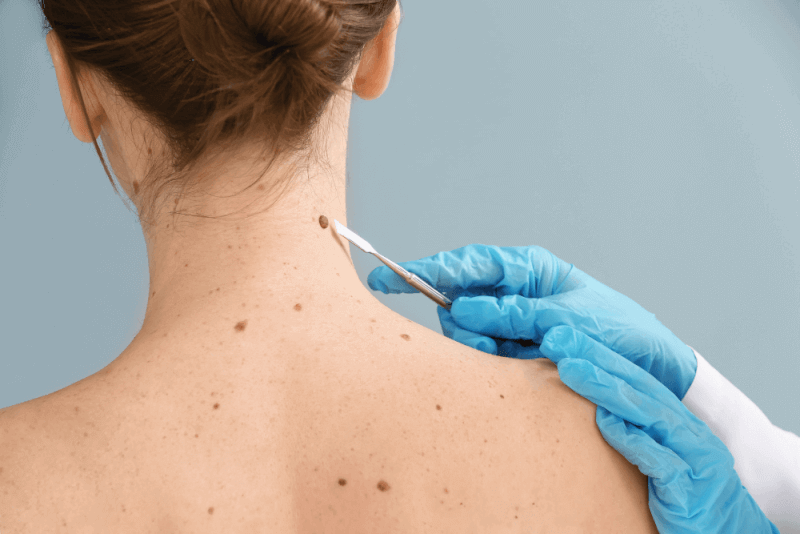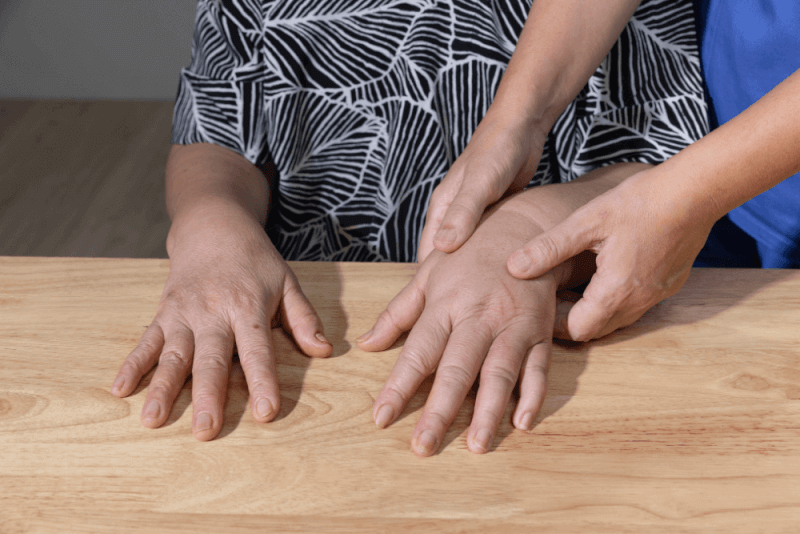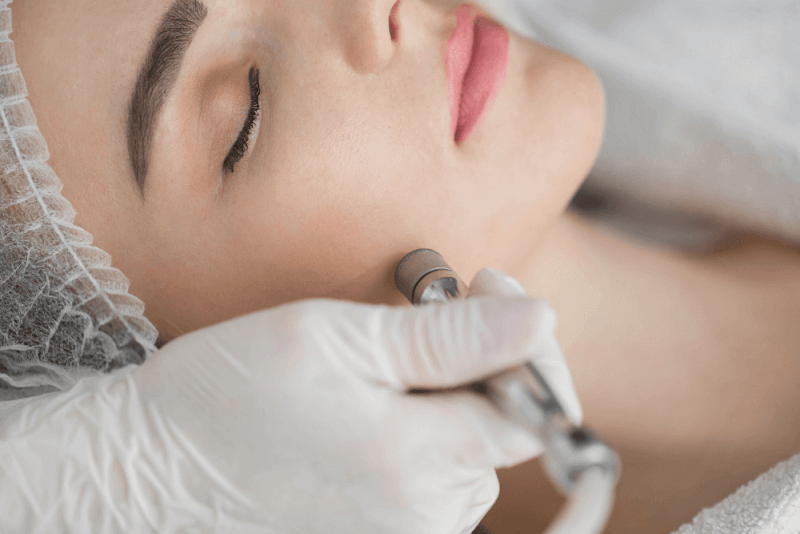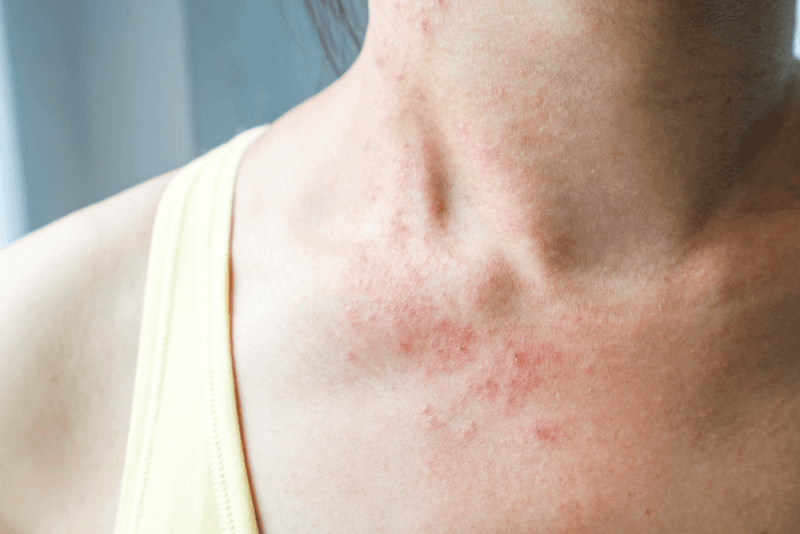What is skin cancer?
It is the uncontrolled growth of epidermal cells in the outermost layer of the skin, caused by unrepaired DNA damage that triggers mutations.
These mutations lead to abnormal cell growth, resulting in the formation of malignant tumors. Skin cancer can appear differently depending on the patient's skin tone, size, type, and location on the body.
Skin cancer diagnostic criteria
During the diagnosis stage of skin cancer, a dermatologist will first ask if you've noticed any changes in your moles, freckles, or other skin spots.
Afterward, the entire skin is examined, including the scalp. If skin cancer is suspected, some tests are necessary, with a biopsy being the most common.
A biopsy not only helps confirm the presence of skin cancer but also determines its type and stage. For types of skin cancer like large cell squamous cell carcinoma or Merkel cell carcinoma, further tests are needed for staging, including the removal of nearby lymph nodes for examination.
Causes of skin cancer
The cause of skin cancer is DNA damage in skin cells. Mutations cause cell proliferation to go out of control, leading to the formation of cancer cell clusters.
In addition to this, certain factors increase the risk of skin cancer. The main contributors to DNA damage are exposure to harmful rays from the sun and the use of tanning beds.
However, these factors do not explain the development of skin cancer in areas not exposed to sunlight. In addition to harmful UV rays, a weakened immune system and exposure to toxins also increase the risk of skin cancer.
- Regardless of skin color, there is a risk of developing skin cancer. However, people with fair skin are at higher risk due to having less melanin, which provides natural UV protection. Fair-skinned individuals, especially those with blonde or red hair and light-colored eyes, are at increased risk if they freckle or get sunburned.
- Having a history of sunburns during childhood or adolescence is another factor that increases the risk of skin cancer.
- Prolonged unprotected exposure to the sun or UV lamps also increases the risk of skin cancer.
- People living in sunny and hot climates have a higher incidence of skin cancer compared to those in colder climates, with the risk being greater in high-altitude areas.
- Having numerous moles or abnormal moles known as dysplastic nevi increases the risk of skin cancer. People with a history of abnormal moles should have regular check-ups.
- The presence of precancerous skin lesions increases the risk of skin cancer. These precancerous skin growths typically range in color from brown to pink and have a scaly, rough appearance.
- Family history of skin cancer.
- Weakened immune system.
- Exposure to radiation.
- Exposure to certain toxic substances, such as arsenic.
Symptoms of skin cancer
Skin cancer often appears on the face or body of men, while in women, it commonly appears on the lower legs.
Skin cancer can affect people of all skin tones, but in people with darker skin, it tends to develop on the palms, soles of the feet, or under the nails.
The most common sign of skin cancer is a change in the skin. Other symptoms of skin cancer include:
- New moles.
- Moles that bleed, change shape or color.
- Pearly or waxy bumps on the face, ears, or neck.
- Flat, pink, red, or brown skin discoloration or swelling.
- Areas of skin that resemble scars.
- Sores with a scaly appearance, central depressions, or frequent bleeding.
- Sores that do not heal or recur after healing.
- Itchy, bleeding, scaly, rough lesions.
The appearance of skin cancer varies depending on the type of skin cancer the patient has. When examining symptoms, the following points should be considered:
- Symmetry: being irregular in shape.
- Border: blurred or irregularly shaped edges.
- Color: having multiple colors.
- Diameter: being larger than 6 millimeters.
- Evolution: the most important criterion is to pay attention to changes in color, shape, and size in the mole.
Skin cancer treatment methods
If actinic keratosis, known as a precursor to skin cancer, is present, the treatment is usually limited to cleaning the entire area while taking a biopsy sample. Generally, no additional treatment is needed.
Skin cancer freezing
Freezing actinic keratoses and some small, early-stage skin cancers with liquid nitrogen destroys the cancerous cells.
This procedure, known as cryosurgery, causes the cells to thaw and the dead tissue to slough off.
Skin cancer chemotherapy treatment
Chemotherapy for skin cancer involves using various drugs to kill cancer cells. For skin cancer limited to the upper layer of the skin, anti-cancer agents may be applied directly to the skin in creams or lotions. For skin cancer that has spread to other parts of the body, systemic chemotherapy is necessary.
Skin cancer radiation therapy
Radiation therapy uses X-rays to kill cancer cells. It is often used when surgery does not remove all of the cancerous cells.
Photodynamic therapy for skin cancer
This treatment combines laser light with drugs that make cells sensitive to light, effectively killing cancer cells.
Biological therapy for skin cancer
Biological therapy uses the body's immune system to kill cancer cells.
Skin cancer surgery
Various surgical methods are used in the treatment of skin cancer. The choice of method depends on the type and stage of the cancer.
Methods of skin cancer surgery
There are three different surgical methods used in the treatment of skin cancer. These methods include:
Excisional surgery
This surgical method can be applied to all types of skin cancer. In this method, the cancerous tissue, along with some healthy tissue, is cut out. In some cases, a wide excision may be recommended.
Mohs surgery
This method is used to treat both basal and squamous cell skin cancers. It is especially preferred for treating larger, recurrent, and difficult-to-treat skin cancers. It is used particularly in areas where preserving the skin is important.
In Mohs surgery, the surgeon removes each layer of skin while examining it under a microscope until no abnormal cells remain. This allows for the removal of less healthy tissue surrounding the lesion.
Curettage and electrodessication
After removing most of the cancerous tissue, a device with a circular blade is used to scrape away layers of cancer cells. An electric needle may be used to destroy the cancer cells, and liquid nitrogen may be used to freeze the edges. This simple and quick procedure is used to treat basal cell cancers or squamous cell cancers.
Side effects of skin cancer surgery
Side effects that may occur after skin cancer treatment include:
- Excessive bleeding.
- Infection.
- Changes in skin sensation.
- Permanent or temporary numbness around the surgical site.
- Itching.
- Long-lasting scars.
- The possibility of revision surgery in the future.
Recovery process for skin cancer patients
How patients feel after skin cancer surgery depends on the surgical procedure performed. For small skin cancers, procedures are usually done under local anesthesia while the patient is awake.
Therefore, patients may be discharged the same day after surgery. For larger skin cancers or operations performed under general anesthesia, an overnight hospital stay may be required.
After general anesthesia
Patients who have undergone general anesthesia are taken to a recovery room after surgery. Initially, an oxygen mask or cannula is applied to provide adequate oxygen. It is normal for patients to feel dizzy and weak when first waking up from anesthesia.
The patient's blood pressure and oxygen levels are continuously monitored. Once the patient is sufficiently awake, they are taken to their room. While in their room, patients receive regular wound care.
Pain control
Pain is usually well controlled after surgery. If necessary, pain relievers are given to patients in tablet, drop, or liquid form.
In some surgeries, a nerve block injection may be applied to the nerves near the surgical area. In addition, patient-controlled analgesia may be offered, allowing the patient to adjust the dose of pain medication.
Eating and drinking
Patients are informed by the doctor and medical team about when they can eat and drink after surgery.
Movement
When patients can get out of bed depends on the doctor's permission. The type of surgery also affects when the patient can move.
Usually, patients are encouraged to stand up on the same day or the day after surgery. If patients cannot move on their own, the healthcare team will assist.
What should skin cancer patients pay attention to?
People who have had skin cancer are at higher risk of developing skin cancer again. Therefore, there are some important points to consider after cancer treatment. These include:
Regular skin checks
It is important to be aware of how your skin normally looks. This helps to notice any changes in the skin or potential signs of skin cancer.
In addition, if there is any change in the area where the first skin cancer occurred, it is important to see a doctor.
Precautions to take for protection
After treatment, skin cancer patients should take the following precautions to protect themselves from the harmful rays of the sun:
- Wearing tightly woven cotton clothing.
- Choosing long-sleeved shirts and pants.
- Wearing wide-brimmed hats that shade the face and neck and using 100% UV-protective sunglasses.
- Using sunscreens with a high protection factor.
- Avoiding going outside during peak UV hours.
- Not sunbathing.
Choosing sunscreen
When choosing sunscreen, skin cancer survivors should consider the following points:
- The sunscreen should have a minimum SPF of 15. However, for better protection, it is advisable to choose sunscreens with SPF 50 or higher.
- Apply plenty of sunscreen.
- Reapply sunscreen throughout the day as long as you are outside.
- It is important that the sunscreen offers UVA and UVB protection.
Vitamin D usage
Avoiding sun exposure to prevent skin cancer can lead to a decrease in vitamin D levels.
This, in turn, can trigger various health problems. To prevent this, it is important to take vitamin D supplements or maintain a diet rich in vitamin D.
Stages of skin cancer
Cancer stages indicate the extent of cancer in the patient's body. In skin cancer, stages are numbered from 0 to 4.
Generally, a higher number indicates that the cancer is more advanced and harder to treat. However, melanoma staging differs from other skin cancer stages.
Melanoma staging
Melanoma cancer is staged as follows:
Stage 0
Melanoma is confined to the upper layer of the skin.
Stage 1
Melanoma at this stage is low-risk, with no signs of spreading. It is usually treated with surgery.
Stage 2
In stage 2 melanoma, there are signs indicating a risk of recurrence, but no signs of spreading at this stage.
Stage 3
At this stage, melanoma spreads to nearby lymph nodes or adjacent skin.
Stage 4
In the final stage of melanoma, metastasis occurs to distant lymph nodes and skin, as well as internal organs.
Non-melanoma staging
Other types of skin cancers, aside from melanoma, are staged according to the following standards:
Stage 0
Cancer cells are confined to the uppermost layer of the skin.
Stage 1
Cancer spreads to the middle layers of the skin.
Stage 2
Cancer is seen in both the upper and middle layers of the skin and progresses to the deeper layers and nerves.
Stage 3
At this stage, cancer cells spread to lymph nodes as well as skin cells.
Stage 4
In this final stage of skin cancer, cancer cells spread to other areas, including the liver, brain, and lungs.
Types of skin cancer
The type of skin cancer is determined by the type of cell in which the cancer originates. There are many different types of skin cancer, but the most common include:
Basal cell cancer
Basal cell carcinoma develops in areas exposed to sunlight, such as the neck, shoulders, ears, scalp, back, and face. It is caused by the uncontrolled growth of basal cells in the upper layer of the skin.
The primary cause of basal cell cancer is cumulative exposure to UV radiation. Basal cell carcinomas, if not treated early, can cause significant local damage. However, they rarely metastasize and are rarely fatal.
Symptoms of basal cell cancer
Symptoms of basal cell carcinoma may include:
- Pearly or waxy bump.
- A sore that bleeds, crusts, or recurs after healing.
- Flat, skin-colored or brown lesion.
Squamous cell cancer
Another type of skin cancer that occurs in the epidermis is squamous cell carcinoma. It is caused by the uncontrolled proliferation of squamous cells and is common on the ears, face, scalp, hands, and neck.
It is particularly common in areas affected by aging and sun damage. It is caused by tanning and prolonged UV exposure.
Symptoms of squamous cell cancer
Symptoms of squamous cell skin cancer may include:
- Hard, red nodule.
- A flat lesion with a scaly and crusty surface.
Melanoma
Melanoma is a type of skin cancer that develops in the melanocytes, the cells that give skin its color. Therefore, it can occur even in areas of the body that are not exposed to the sun. Tanning and using tanning beds increase the risk of melanoma.
Melanoma is the most dangerous type of skin cancer among the three most common types of skin cancer. When detected early, melanoma can be successfully treated. However, it is a type of skin cancer with a risk of death.
Symptoms of melanoma
Symptoms of melanoma may include:
- Brown spots with darker specks.
- A mole that changes color, size, or feel, or bleeds.
- Lesions with irregular borders and red, pink, white, blue, or blue-black sections.
- Painful lesions that itch or burn.
- Dark lesions on the palms, soles, fingertips, toes, mouth, vagina, or anus.
Less common types of skin cancer
Although the three types mentioned above account for the majority of skin cancer cases, there are also some rare types of skin cancer, including:
Kaposi sarcoma
Kaposi sarcoma is a type of cancer that develops in the skin's blood vessels, causing red or purple patches on the skin or mucous membranes. It is particularly common in people with weakened immune systems.
Kaposi sarcoma is more common in certain high-risk areas, including young men in Africa and older men of Jewish descent in Italy and Eastern Europe.
Merkel cell carcinoma
Merkel cell carcinoma causes firm, shiny nodules on or just beneath the skin, often found on the head, neck, and trunk.
Sebaceous gland carcinoma
This rare but aggressive cancer begins in the oil glands of the skin. It typically starts as hard, painless nodules and can develop anywhere, but is most often found on the eyelid.
Skin cancer prevention methods
Most skin cancers can be prevented. To prevent skin cancer, attention should be paid to the following:
- Avoid outdoor activities during the midday hours when the sun's rays are strongest. Even on cloudy days, be cautious as clouds do not effectively filter UV rays.
- Use sunscreen throughout the day, all year round. While sunscreens may not completely filter out radiation that can cause melanoma, they play an important role in sun protection. For better protection, choose sunscreens with at least SPF 30, reapply every two hours, and apply generously.
- Since sunscreens do not provide complete protection against UV rays, physical protection with tightly woven clothing is essential.
- Avoid tanning beds.
- Certain medications, including antibiotics, can make the skin more sensitive to UV rays. Therefore, consult your doctor or pharmacist about the side effects of any medications you are taking.
- Regularly check your skin for any changes to catch potential issues early.











